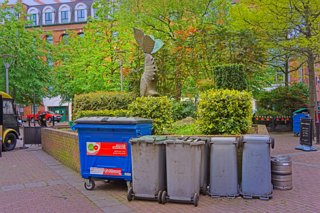TWO SCULPTURES AND A CLOCK
A local told me that the street was named in honour of Amelia Earhart. There is some logic to the claim, even though it is totally false. "In May 1932, Northern Ireland and Londonderry was written into aviation history by aviatrix Miss Amelia Earhart, who during that year became the first solo woman to fly across the Atlantic from Harbour Grace, New Foundland, in Canada. Northern Ireland wasn’t her planned destination, that was Paris, and the province was fortunate that she was forced to land in fields near Ballyarnett Racecourse, Londonderry".
Amelia Street, located in Belfast, has a rich history. It was once at the heart of Belfast’s red light district. This fact is commemorated by well-known poet Frank Ormsby in ‘Amelia Street’ which describes the area as ‘the sum of lasting miseries’.
Amelia Street in Belfast, located near the Europa Hotel, carries a rich history entwined with the city's post-war regeneration efforts. The street, named after Princess Amelia (1783-1810), daughter of King George III, has witnessed significant transformations over time.
At the intersection of Amelia Street and Brunswick Street lies Blackstaff Square, a small public space with a unique story. Once a World War II bomb site, it was redeveloped into a square symbolising Belfast's resilience and rebirth. The square's name pays homage to the River Blackstaff, a prominent waterway flowing through the city.
In its prime, Blackstaff Square featured a freestanding public clock and, for many years, housed the sculpture "Regeneration" by Anna Cheyne. The clock served as a functional and aesthetic centrepiece, while the bronze and fiberglass sculpture represented the city's ongoing renewal and transformation.
There used to be a freestanding public clock on Amelia Street near Blackstaff Square. However, it disappeared due to the construction of the Maldron Hotel. Unfortunately, I couldn’t find more detailed information about this clock.
Adding to the square's complex history is the controversy surrounding another sculpture, "Monument to the Unknown Woman Worker" by Louise Walsh. Initially commissioned for Blackstaff Square to honour the women who worked in the nearby red-light district, the sculpture faced opposition and was eventually relocated to the entrance of the Europa Hotel.
Today, Blackstaff Square stands as a testament to Belfast's past and its ongoing evolution. The absence of the clock and the "Regeneration" sculpture, coupled with the relocation of the "Monument to the Unknown Woman Worker," serve as reminders of the intricate and sometimes contentious relationship between public art, history, and urban development.
Despite the changes and challenges, Amelia Street and Blackstaff Square remain integral parts of Belfast's urban fabric. They symbolise the city's ability to adapt and regenerate, even in the face of adversity, and continue to spark conversations about the role of art and public spaces in shaping the city's identity.
Amelia Street, located in Belfast, has a rich history. It was once at the heart of Belfast’s red light district. This fact is commemorated by well-known poet Frank Ormsby in ‘Amelia Street’ which describes the area as ‘the sum of lasting miseries’.
Amelia Street in Belfast, located near the Europa Hotel, carries a rich history entwined with the city's post-war regeneration efforts. The street, named after Princess Amelia (1783-1810), daughter of King George III, has witnessed significant transformations over time.
At the intersection of Amelia Street and Brunswick Street lies Blackstaff Square, a small public space with a unique story. Once a World War II bomb site, it was redeveloped into a square symbolising Belfast's resilience and rebirth. The square's name pays homage to the River Blackstaff, a prominent waterway flowing through the city.
In its prime, Blackstaff Square featured a freestanding public clock and, for many years, housed the sculpture "Regeneration" by Anna Cheyne. The clock served as a functional and aesthetic centrepiece, while the bronze and fiberglass sculpture represented the city's ongoing renewal and transformation.
There used to be a freestanding public clock on Amelia Street near Blackstaff Square. However, it disappeared due to the construction of the Maldron Hotel. Unfortunately, I couldn’t find more detailed information about this clock.
Adding to the square's complex history is the controversy surrounding another sculpture, "Monument to the Unknown Woman Worker" by Louise Walsh. Initially commissioned for Blackstaff Square to honour the women who worked in the nearby red-light district, the sculpture faced opposition and was eventually relocated to the entrance of the Europa Hotel.
Today, Blackstaff Square stands as a testament to Belfast's past and its ongoing evolution. The absence of the clock and the "Regeneration" sculpture, coupled with the relocation of the "Monument to the Unknown Woman Worker," serve as reminders of the intricate and sometimes contentious relationship between public art, history, and urban development.
Despite the changes and challenges, Amelia Street and Blackstaff Square remain integral parts of Belfast's urban fabric. They symbolise the city's ability to adapt and regenerate, even in the face of adversity, and continue to spark conversations about the role of art and public spaces in shaping the city's identity.

TWO SCULPTURES AND A CLOCK